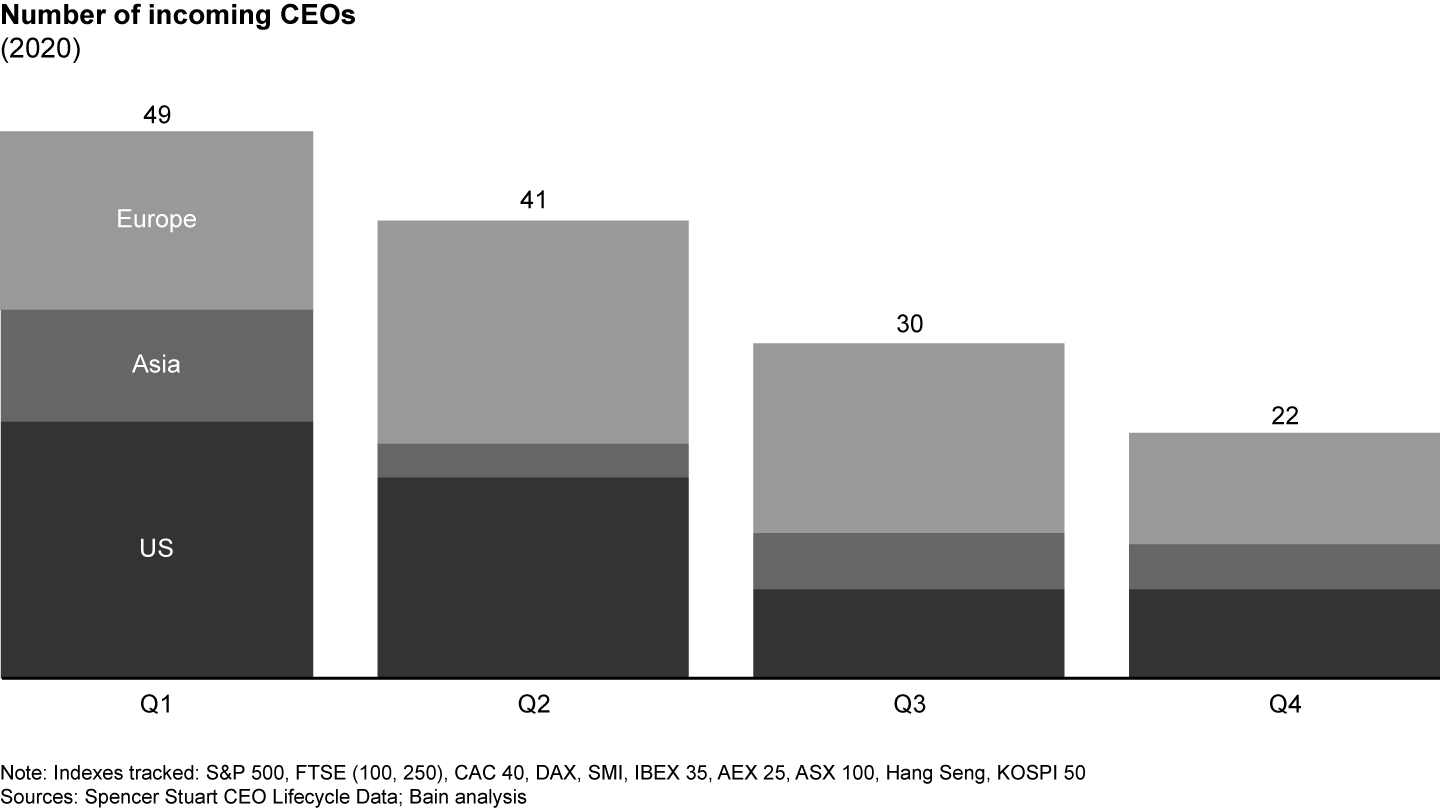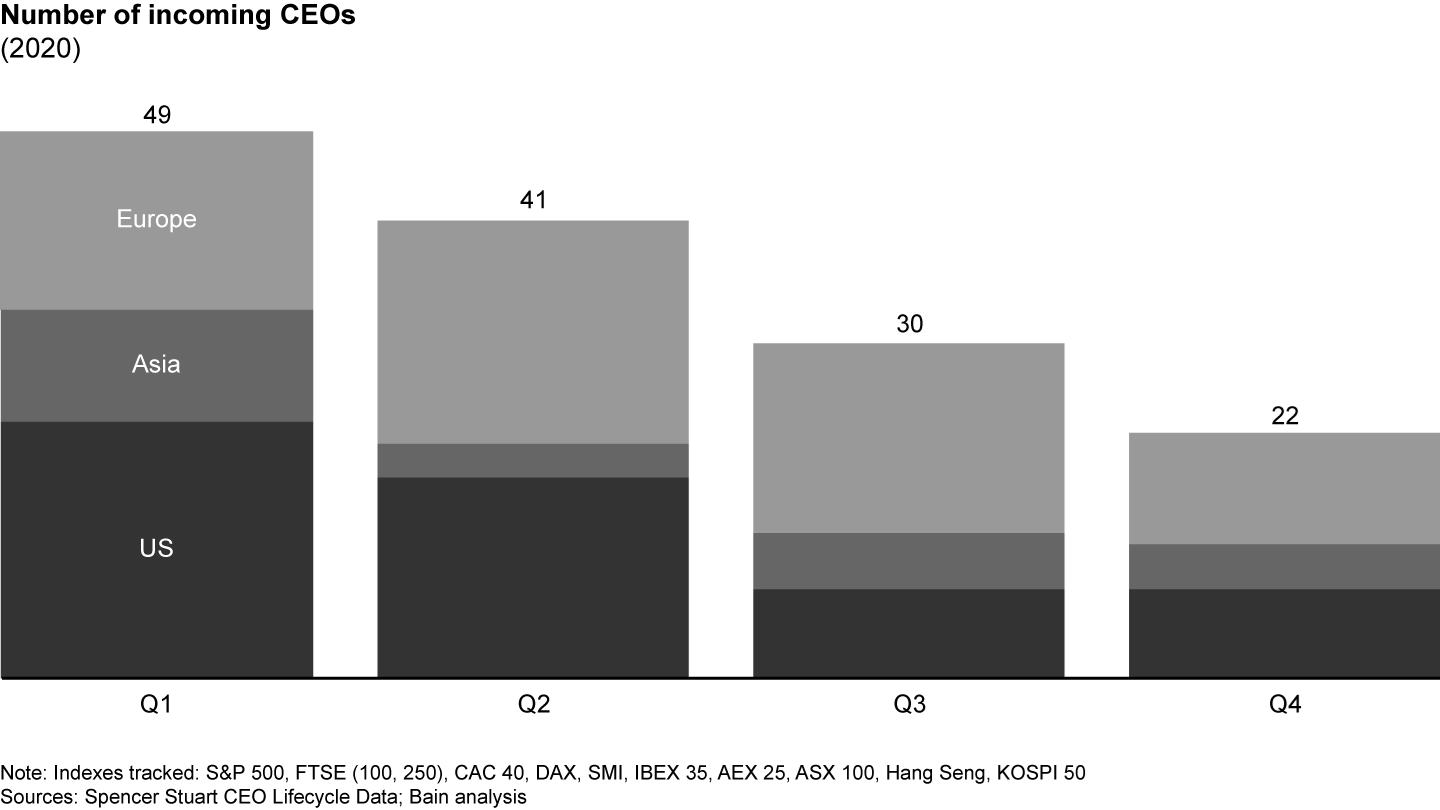Brief

Boards tend to pause leadership successions during turbulent times, and 2020 was no exception. Globally, CEO transitions fell 42% between the first and second halves of the year as the economic strain of the Covid-19 pandemic intensified (see Figure 1). Transitions declined a modest 4% for the year compared with the average annual number in 2018 and 2019, reflecting the strong pace of transitions early in 2020.
Global CEO transitions in 2020 fell sharply from a first-quarter high


Written in collaboration with
Written in collaboration with

Following our July 2020 study of CEO transitions during periods of turmoil, we analyzed the pandemic’s full-year global impact on CEO succession. Despite regional differences, the broad trends followed the same pattern as previous crises:
CEO succession slows in a crisis. During the past three global recessions, CEO transitions fell by as much as one-third from their pre-crisis highs. This pattern largely held true in 2020, with some differences by region based on the timing of Covid-19 outbreaks, which struck Asia first, followed by Europe and then North America. Asia experienced the steepest decline in CEO transitions during 2020, down 23% compared with the 2018–2019 average. The region’s sharpest drop was in Q2. In the US, CEO transitions plunged 61% in the second half of 2020 from a near-record level in the first half of 2020. In Europe, Q1 and Q4 dips were offset by Q2 and Q3 spikes, leading to a modest increase of 3% for the year over the average annual number in 2018 and 2019.
CEO successions drop most in hard-hit industries. In prior crises, boards in the hardest-hit sectors were the most likely to delay CEO successions. This pattern was harder to detect in 2020, possibly because the Covid-19 crisis didn’t originate in any one sector and affected the entire economy. CEO transitions declined most in Asia’s industrial goods and consumer goods and services sectors, in the US technology sector, and in Europe’s healthcare industry. Following a quick recovery of financial markets, CEO transitions in financial services in Europe rose at a fast clip.
Boards seek stability in volatile times. In past crises, decisions to oust CEOs for poor performance or scandal—arguably the most critical move boards make—declined even more dramatically than transitions overall. Faced with an uncertain future, boards tend to retain their chief executive, even if leadership succession was high on the agenda before the crisis hit. Transitions under pressure in the US fell by 71% from the first half of 2020 to the second and declined by 25% in 2020 compared with 2019. Asian companies achieved stability by promoting more CEOs from within: 82% of Asia’s new CEOs were promoted internally, compared with 76% in 2019. By contrast, European companies were more likely to select outsiders in 2020—47% of new CEOs came from outside vs. 26% in 2019. European CEO transitions followed a similar trend after the global financial crisis. One possible explanation is that boards opting for outside talent to replace a CEO were preparing for major transformations.
Board directors step into the leadership void. A record share of the US transitions in 2020 involved a board director moving into the CEO role. Boards often choose one of their own, especially directors with CEO experience, as a steady hand in a crisis. In normal times, the choice of a board member as CEO is often an interim solution providing time to search for a permanent successor. In 2020, however, many companies made these appointments permanent to provide stability to their organizations, particularly at a time when meeting external candidates was challenging.
Outlook for 2021
Transitions will pick up midyear. CEO transitions tend to rebound as uncertainty wanes, often spiking two years after the depth of a crisis. Given the speedy market recovery in 2020, continued access to liquidity, and the prospect that vaccines will be widely available by the middle of 2021, we expect CEO succession will rebound in tandem with the overall economic recovery. If historical patterns repeat, transitions in 2022 could spike as much as 30% above pre-crisis levels. Boards will look to replace three specific CEO profiles: underperformers, aging or exhausted CEOs ready to retire—in some cases, activating a long-term succession plan put on hold—and those whose profile is a poor match for companies requiring a dramatic business model shift.
The business model will help shape the future CEO profile. A silver lining in the crisis has been the dramatic acceleration in the development of high-potential leaders who faced new challenges and proved their mettle. Having seen these leaders in action, boards that emerge from the pandemic with a stable business model will be more comfortable promoting from within, confident their executive is deemed ready to assume the role of CEO. Companies grappling with disrupted business models and in need of new strategies and capabilities may be more likely to consider external candidates. As they search for talent, leading boards will debate the ideal profile of a future leader, based on the company’s goals and evolving business context. They will also consider trade-offs between candidates’ potential and their experience.
Crisis-critical leadership traits will remain important. Even as the pandemic abates, and boards shift their focus to investing in business resilience, leaders will continue to grapple with uncertainty and complexity. The Covid-19 crisis underscored the critical importance of adaptability, openness to new ideas, and long-term orientation. Top-performing executives in the coming decade will display courage, empathy, and humility, enabling them to lead through long stretches of uncertainty and to steer businesses through rapid change.
The authors would like to thank Michelle Belk for her contributions to this article.
Written in collaboration with
Written in collaboration with
![]()